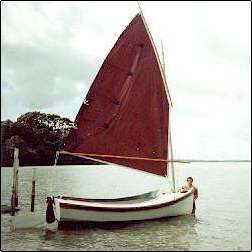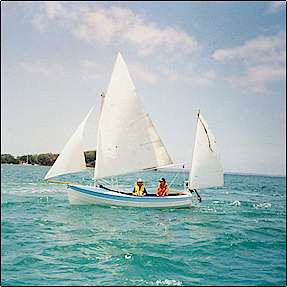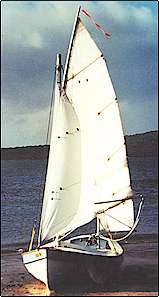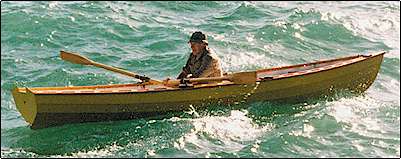|
Camping is a matter of comfort. I go cruising to enjoy the
sights, smells and sounds of new surroundings, and I find that
exploring is much more enjoyable when I am well rested and fed. I also like to be able to
set up camp quickly, especially if the weather has caught me
out.
One of the great things about camp cruising in
small boats is that you have the ability to carry more, and heavier,
gear, so this kind of camping can be quite different to others. Comfort is
all-important. I can
stand being miserable for only a short time, so I have over many
years developed my priorities and equipment so that I can travel, if
not in five-star luxury, then at least in a style that I can live
with.
When planning the equipment, it helps to break
the list down into categories---the most important first.
|

Set
up for the night in Houdini.
Although the boat is only 13ft 9 in long I have an
airbed under my sleeping bag,
my galley box with stove and utensils, a couple of
plastic buckets, ( you dont wash your face in the purple one,
it is for “other “ uses) spare dry clothes and enough
books and food for a week.
The tent is a cheap blue polytarp converted with two
sided sticky tape and brass eyelets.
Very comfortable. |
Shelter
If your shelter is inadequate, you may die---a
blunt statement, but true.
In the open, exposure will kill you faster than anything
except a major accident.
You can live for a week or so without water, a month or more
without food, but only hours if wet and cold. Your shelter should be very
quick to erect and be windproof, both in terms of the draughts
inside, and not being blown away by the wind.
I have a two-man mountain tent for when I am
alone, and a four-man unit for when there are two. These are the type with
fiberglass 'bows' from corner to corner, have two skins (an inner
and a 'fly'), a built-in groundsheet, and will stand without pegs
once you've put some gear inside to hold them down. I once spent ten hours
inside the smaller one, lying in my sleeping bag, with wind gusts
flattening the fabric down on top of me---not sailing weather at
all!
 I do test-assemble my tent
on the lawn before I go; a small boat is not always able to keep to
a schedule, and one needs to be able to erect the tent in the
dark. I do test-assemble my tent
on the lawn before I go; a small boat is not always able to keep to
a schedule, and one needs to be able to erect the tent in the
dark.
Sleeping
A good sleep can make an impossible situation
look not nearly so bad.
I use an airbed---not your cheapo beach floatly thing, but a
‘real’ designed-for-the-job one. I carry a small foot pump
with which to inflate it; hyperventilation sets in after 100 puffs
if I try to inflate the thing, and I have the space, so why
not?
Sleeping bags are fine. Bear in mind, though, that
it tends to get colder than you would expect when close to water, so
take a good one. A
cotton liner/sheet will make quite a difference (air it for a few
minutes every morning to keep your bed fresh). A blanket or a rug is a
worthwhile thing to have, and of course I couldn’t sleep without my
pillow. This whole lot
stows inside doubled plastic rubbish sacks, which in turn are inside
a tramper’s pack and strapped in under the foredeck. Even after swamping Houdini,
my bed was dry!
Cooking

Chris
and Annette Peard sailing their yawl rigged Navigator sailing dinghy
off Torbay on New Zealand's Waitemata Harbour, with her two masted
rig and multiple sail combinations,
full built in bouyancy,
large locker space and wide side decks
this is a boat particularly well suited to coastal cruising .
|
Why eat poorly just
because you are on holiday?
After all, this is supposed to be enjoyable. My principal heat source,
after trying many different stoves, is a Primus camping stove of the
type that screws onto the top of a ‘2202' 450g. Propane gas
cartridge. This
provides plentiful heat.
I carry a solid ‘tablet’ fueled emergency stove as a back-up,
but rarely use it, and occasionally cook on a campfire. Be careful with campfires
though---few property owners appreciate the risk.
I now have my stove built into a box, with a
stainless steel tray under the burner, and the lid fitted with flaps
to form a windbreak. My
‘galley box’ is large enough to carry all my cooking gear, including
a spare gas cartridge, is solid enough to stand or sit on; and has
rope handles, making it easy to carry. Its size is about 700 mm
long, 350 mm wide, and 300 mm high. It does duty as a seat, a
writing desk, a table, and a washstand. As well as the stove I keep
the following items inside: |
A deep sided 250 mm diameter cast-iron frying
pan with lid. This
fries, grills, stews and---by putting another container inside with
the lid on---bakes.
Makes great bread!
Mix the ingredients before you go, then just add the yeast
and water when you bake it.)
|
*A 150 mm cast-iron pot
with lid.
*A ½ litre camp kettle.
*A 2 litre billy with lid for big lots of hot water.
*Three small nesting plastic bowls.
*A small stainless steel bowl which
does the baking in the big pan.
*Big tin plate
*Two each stoneware plates and bowls.
*Two mugs
*Sharp serrated knife
*Spatula
*Mixing spoon
*Wooden stirring and scraping thing
*Two knives, forks and spoons.
*Salt, pepper, dried herbs
—chives, rosemary, bay leaves—brown sugar
*Matches in a watertight jar
*Paper towels
*Dishwashing liquid such as Sunlight
—use it to wash your body too!
*Two dishtowels
*Scotchbrite scrubbing pad
*Hard bristle kitchen scrubbing brush
|

Ddraigge
( Welsh for Dragon) is Navigator hull number one ,
built by Bob Jenner she is still cruising, although with
other owners.
|
There’s not much you can’t cook with the
above. You may need to
pre-cook some slow things, then combine the lot and reheat to
serve. A good idea is
to set your galley up at home and try out the recipes in the safety
of the dining room.
With a bit of forethought, you’ll have great grub when
away.
For the moment I use things like UHT custard
with those little Christmas puddings you buy in plastic pots. I mix bread and scone mixes
and store ready to use in Tupperware containers.
Tinned meats, such as Plumrose hams and smoked tongue, are
great. Bacon will last
a surprisingly long time stripped of its plastic wrapping and kept
cool.

Windsong
, a shot over the helmsmans shoulder on a not very nice day. Note the careful stowage of the gear and the
good wet weather clothing, care and preparation can make
the worst days sailing better than the best day in the office. |
I take lots of fresh fruit, UHT milk in small
containers (one per day for me), and fruit juice to keep the vitamin
C going. A friend of
mine, who should have known better, complained to me that her whole
family had come down with boils after three weeks away on their big
yacht. Scurvy, caused
by a lack of fresh fruit, was my diagnosis, and sure enough, the
boils disappeared soon after they came ashore and went back to their
usual diet.
Eating well is essential. Simple meals are fine, but
good quality and a balanced diet are major contributors to a happy
cruise. |
Clothing
It should be possible to rake up enough
clothing from the average wardrobe for at least the first few
trips. Loose fits are a
help; try for light clothes overlain with warmer ones, and
water/windproof over those.
I find that if I can stay warm and dry it’s no problem to
peel a layer or two off.
Any of the now-common synthetic fleeces are useful ‘warmers’,
but bear in mind that they are not usually windproof. Denim jeans, on the other
hand, are very poor outdoor wear, particularly when wet.
| A really good set of wet
weather gear is important, and some of the best gear I’ve seen comes
from the industrial suppliers like NZ safety.
Remember that a disproportionately large
amount of a body’s total heat loss is through the head, so if you’re
going to buy anything get a snug hat from a ski or outdoor
shop. The other thing I
wouldn’t leave behind is a pair a sunglasses’ looking into the sun
for hours, particularly when it’s reflected off the sea, is a
sure-fire recipe for a headache. |

Camp
cruising in a rowing boat is rather like tramping, but on the
water. You can
though carry a lot more gear and by rowing early in the morning
and during the evening calm you can cover a lot of ground.
Seagull , beautifully
built by Colin Quilter
is a really nice example of this simple design. |
Entertainment
I read, on average, a paperback a day when
cruising (which would be a worry should I ever contemplate a
circumnavigation), so raid the second-hand bookshops on a regular
basis. Music is
important, so I have a ‘sports’ model waterproof radio, as well as
my flute so that I can make my own melodies. I also carry a notebook in
lieu of a formal log, and I am beginning to draw with a pencil and
ballpoint.

Frank
Bailey in his 15 ft Joansa
-- 72 years
old and heading off up the harbour to have lunch at some quiet
spot. Cruising can
be for an hour or two, or a year or two. |
I carry spares for the essentials; flares,
tools, a kerosene (hurricane) lamp, a hatchet, a lifejacket (one
for each person on board), a first-aid kit, and a big Swiss Army
pocketknife, among other things. Be sensible, you are often
out of range of help and supplies, |
so you need to be pretty
self-sufficient—but don’t take the kitchen sink (use a plastic
bucket instead).
Cruising is small boats is a sociable
exercise. I find that
in bigger boats I meet very few people; most act as though their
neighbors in an anchorage are not there. However, a small boat easing
through the crowd to its anchorage, obviously having traveled from
afar, attracts people like bees to honey. The number of meals I’ve
enjoyed in return for a telling of my adventures is amazing, and the
friends I’ve made have been
treasures. |
![]()